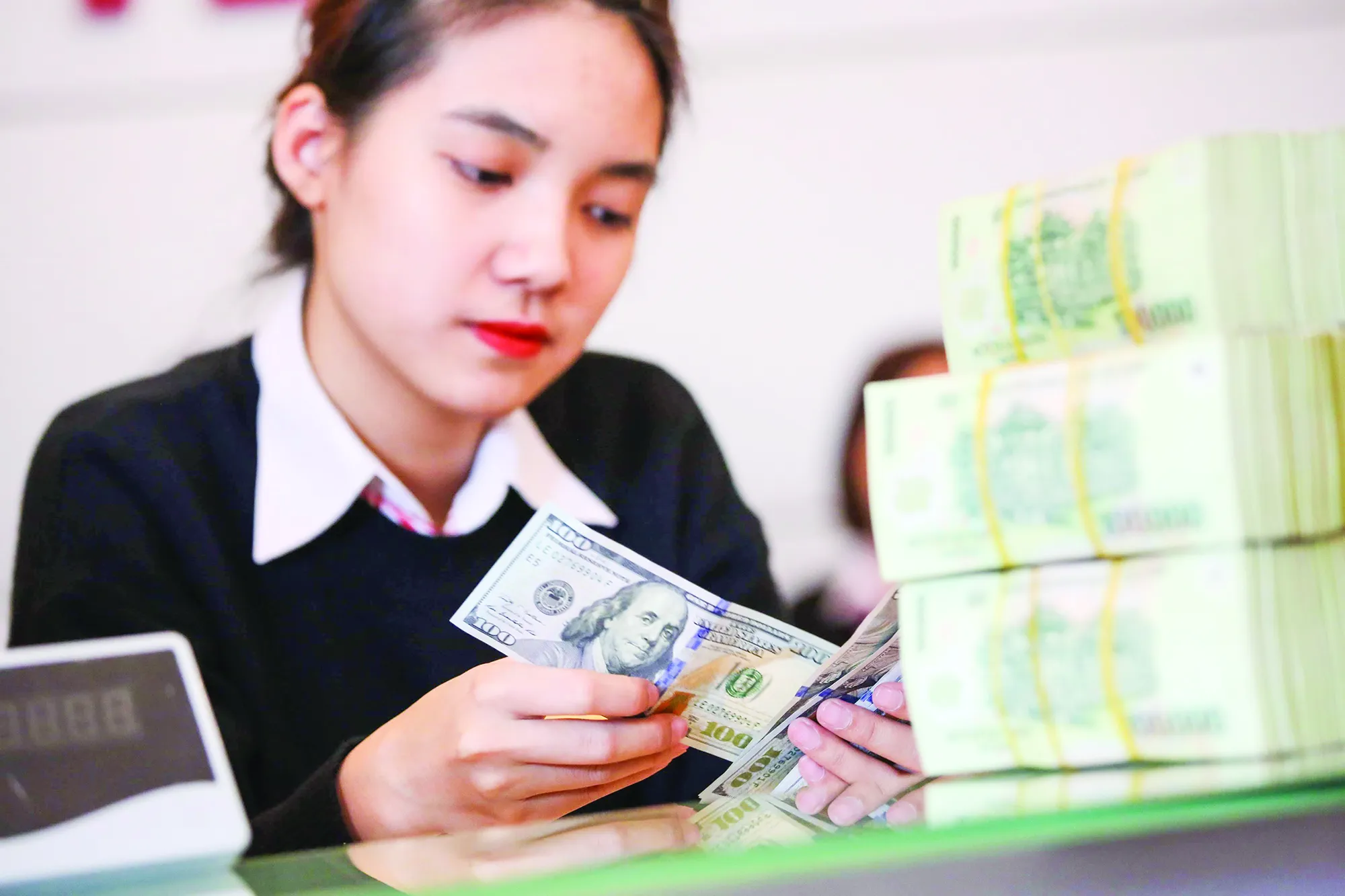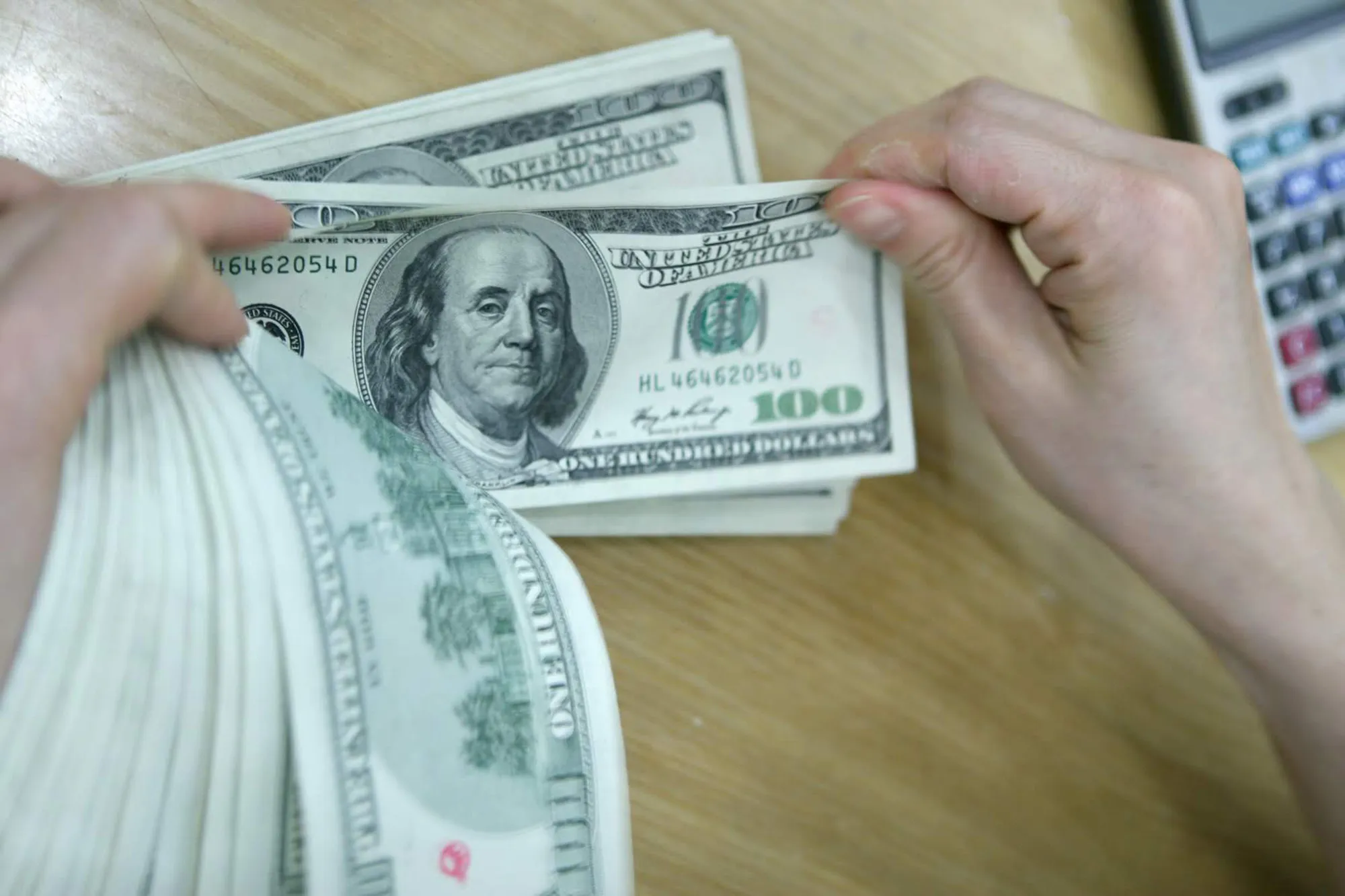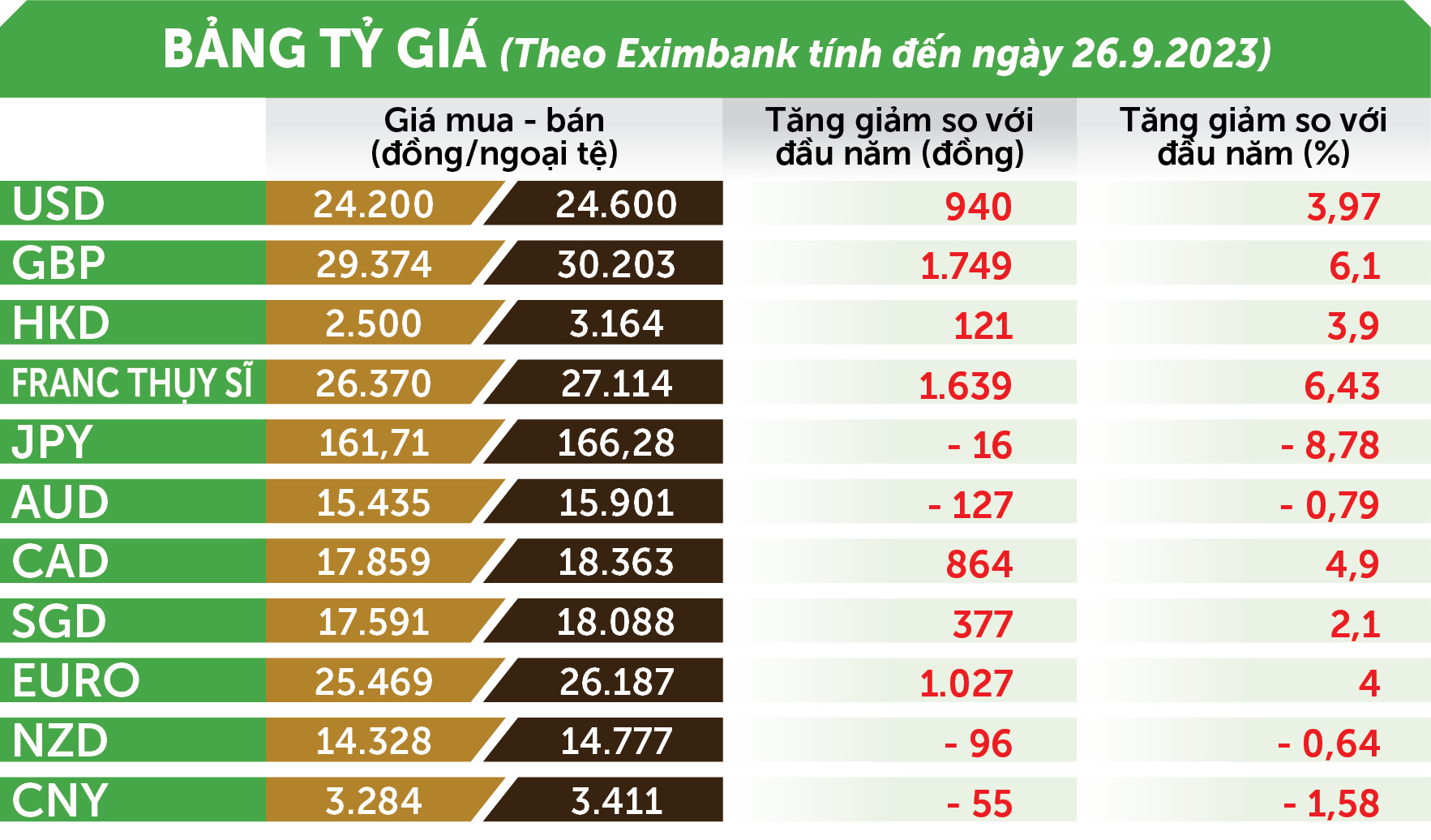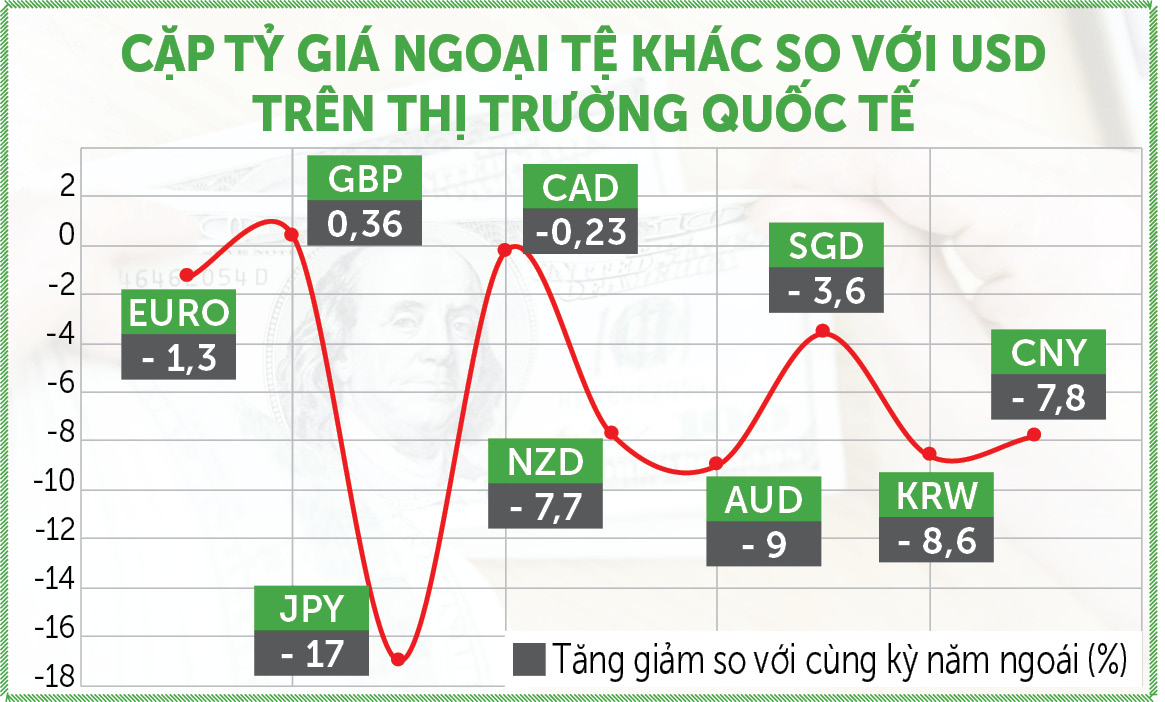At the time we wrote this article (late September 2023), the domestic exchange rate was under great pressure from the highest USD interest rate in more than 20 years to control inflation by the US Federal Reserve (Fed).

The time of strong USD
The USD has been steadily increasing in value for many weeks, before and after the Fed decided to keep interest rates at a high level of 5.25 - 5.5% / year at the September meeting. The USD-Index returned to the highest level reached 1 year ago, up to 105.8 points. This is the third wave of increase this year for the greenback, fluctuating in the range of 99.7 points to 105.8 points. The USD firmly increased after the Fed revealed the possibility of raising interest rates once more this year, followed by 2 cuts in 2024 instead of 4 times as before. Since starting to tighten policy in March 2022, the Fed is expected to carry out dozens of interest rate hikes to control inflation to the target of 2%.
The rise in the US dollar has caused other currencies to fall sharply. The Japanese yen is now back at a 32-year low. Each US dollar is worth more than 149 yen, compared to 127 yen (JPY) at the beginning of the year. The USD/JPY pair has fallen by about 17%, breaking the lowest level reached in October 2022. The Bank of Japan (BoJ) maintained its ultra-loose monetary policy and kept interest rates unchanged in September, but expressed caution about "extreme uncertainty" over the domestic and foreign growth outlook. At its July meeting, the BoJ eased its control over the bond yield curve and allowed long-term interest rates to move in line with rising inflation. This was the first policy change since Kazuo Ueda took office as BoJ Governor in April 2023.
In addition, the Chinese yuan (CNY) also broke its all-time low in September 2023, when 1 USD was worth 7.35 CNY despite a series of sharp daily adjustments to the reference exchange rate from the People's Bank of China (PBOC). The PBOC kept its benchmark lending rate unchanged in September as it tries to support economic recovery and prevent further depreciation of the yuan. The CNY has fallen nearly 10% against the USD since the beginning of the year, to its lowest level in 15 years. China has repeatedly cut interest rates in the past to stimulate demand. Coupled with China's sluggish economic growth, the PBOC's rate cuts have widened the yield gap between Chinese government bonds and US government bonds.
In addition, from the beginning of the year to the end of September, some other currencies also depreciated against the USD such as VND decreased by about 3%, Euro decreased by 1.3%, CAD decreased by 0.23%, NZD decreased by 7.7%, AUD decreased by 9%, Korean won decreased by 8.6%...

USD price increase pulls other foreign currencies down
Tourism benefits, labor export faces difficulties
The decrease in foreign currency prices on the international market has helped the domestic exchange rate adjust proportionally, affecting activities in the Vietnamese economy. In addition to the US, people traveling to Japan and China this year have benefited greatly. Mr. Nguyen Duy (District 4, Ho Chi Minh City) took the opportunity to plan a trip to Japan with a group of friends in November 2023 to see the red leaves. This is the third time he has been to the land of the rising sun in recent years just to "take advantage of the cheap tour". "During the trip in April 2019, each person spent about 70 million VND for the entire 7-day trip, including hotel, food, and transportation between provinces in Japan. At that time, the yen price was about 207 VND/yen, so the converted spending was about 340,000 yen. Now the exchange rate is only 166 VND, with the amount of 70 million VND spent, it can be exchanged for about 420,000 yen, 80,000 yen more than a few years ago, so the spending money will also be more abundant," Mr. Duy calculated.
Working in the tourism industry for 30 years, Mr. Phan Quang ( Hanoi ) admitted that the price of a tour to Japan has never been so cheap. In 2022, the price of a 5-6 day tour to Japan was around 30 million VND/person, but now it is around 25-26 million VND, a decrease of about 15-20% depending on the choice of tourists. "There are many factors that cause the price of a tour to Japan to decrease, but the biggest impact is the sharp decline in the yen. Some other tours such as Taiwan, China... also decreased slightly thanks to the falling exchange rate," Mr. Quang commented.
However, the sharp drop in the yen price also makes many people unhappy, especially Vietnamese workers in Japan, who account for a large proportion of about 345,000 people. The leading market attracting Vietnamese workers is Japan, followed by Taiwan, South Korea... If at the beginning of the year, Vietnamese workers sent 100,000 yen to their families, which was equivalent to 18.2 million VND, by mid-September, it was only equivalent to 16.6 million VND. For about 345,000 Vietnamese workers in Japan, the amount of money "lost" due to the yen's devaluation is very large.
Some Southeast Asian currencies are losing value against the USD.
According to the Institute of Banking and Finance (National Economics University), when the yen depreciates against the USD, it will affect the Vietnamese economy. Specifically, Vietnam's real public debt will decrease; Japanese enterprises' investment in Vietnam will increase; Japanese exports to Vietnam will increase but reduce the efficiency of exports from Vietnam to Japan; and the real income of Vietnamese workers in Japan will decrease.
Similarly, China is a country with high trade with Vietnam, so the sharp depreciation of the CNY also has a big impact on the economic activities of domestic enterprises. Experts pointed out two main impacts. That is, the depreciation of the CNY can put pressure on the USD/VND exchange rate through psychological effects, market expectations about the depreciation trend of the currency compared to the USD as well as concerns about the possibility of money flowing out of emerging economies. In addition, the market expects the depreciation of the CNY to affect the bilateral trade balance between Vietnam and China in the direction of increasing the trade deficit for Vietnam, creating certain pressure on the exchange rate.
Yen debt falls, dollar exports suffer
Dr. Nguyen Huu Huan, Head of the Financial Markets Department, Ho Chi Minh City University of Economics, said that fluctuations in exchange rate pairs against the USD, especially the currencies of countries with which Vietnam has trade and investment activities, will affect the domestic economy. For example, the recent sharp decline in the yen has benefited import businesses as they can import Japanese goods at cheaper prices than before, thereby increasing profits.
On the other hand, export businesses will face a decrease in profits because their goods sold in Japan will bring in less money. In case of price increase, Japanese consumers' demand will likely decrease. For businesses that are borrowing yen, especially thermal power companies, this is good news. When the yen depreciates, businesses will also have to spend less dong to repay their debts.
"Japan is one of Vietnam's major creditors and the largest bilateral creditor as of 2022 with a total loan of about VND274,000 billion. Therefore, the depreciation of the yen also reduces this debt compared to before, helping Vietnam reduce its public debt burden," Mr. Huan cited. On the contrary, the increase in the value of some foreign currencies such as the euro and the pound will affect Vietnam's exports to these markets, according to Mr. Huan. Because the VND is pegged to the USD and is currently only depreciating by about 3%, lower than the exchange rate of other countries, the price of Vietnam's goods is also increasing accordingly and negatively affecting exports. In terms of investment, these countries have not invested much in Vietnam, so the impact is not too great.
Exchange rate remains under pressure
The operating policies of the US and Vietnam continue to show differences. In the context of the US continuing to maintain a tight monetary policy and anchor interest rates at high levels, the State Bank has been one of the pioneering central banks in Asia to lower operating interest rates to support the economy. In addition, VND liquidity has also been maintained abundantly in the context of slow credit disbursement. The above reasons will continue to create a trend for the exchange rate to increase from now until the end of the year.
Mr. Ngo Dang Khoa, National Director of Foreign Exchange, Capital Markets and Securities Services, HSBC VN
Businesses should prevent risks
Enterprises need to take measures to hedge future risks such as purchasing options or forward contracts to hedge exchange rate risks in case foreign currencies depreciate sharply against VND and other currencies. In addition, enterprises should also consider signing USD transaction contracts with partners, which can also help hedge risks, such as the yen continuing to depreciate against USD and VND in the future.
Dr. Nguyen Huu Huan, Head of Financial Markets Department, University of Economics Ho Chi Minh City
The "acrobatic" of world currencies has significantly affected domestic exchange rates. Mr. Nguyen Duc Lenh, Deputy Director of the State Bank of Vietnam (SBV) Ho Chi Minh City branch, said that the recent increase in the domestic USD price is mainly objective and short-term in relation to strong currencies in the world. The increase in the USD price puts certain pressure on the VND/USD exchange rate. To cool down the exchange rate, the State Bank is flexibly operating open market instruments, issuing and buying and selling appropriate credit notes in each period, which have a positive and effective impact on the exchange rate, ensuring appropriate developments according to the management orientation and monetary policy objectives of the State Bank, the target of economic growth and development. Foreign currency supply and demand are guaranteed, the legitimate foreign currency needs of people and businesses are always met. In particular, the import-export balance of payments is still guaranteed, foreign currency supplies still maintain a positive growth rate.
The HSBC research team forecasts that the USD/VND exchange rate will continue to increase in the coming months, although the level of fluctuation may not be as high as in the same period last year, it may reach 24,200 VND/USD, equivalent to a price increase of about 3.5% for the whole year. The reason was explained by Mr. Ngo Dang Khoa - National Director of Foreign Exchange, Capital Markets and Securities Services, HSBC Vietnam - that the USD continues to show strength this year and shows no signs of weakening, in the context that US macroeconomic data has not shown signs of decline. This invisibly creates exchange rate pressure for currencies in the region, including Vietnam.
On the other hand, China has not shown a strong economic recovery after opening up after the pandemic as expected. This development has also caused the CNY to lose a record value this year. China is a major trading partner of Vietnam, so the VND has been under certain pressure since then. In addition, net selling of stocks along with seasonal factors when the demand of import-export enterprises increases in the last months of the year, further increasing the demand for foreign currency.
Similarly, Mr. Nguyen Huu Huan said that the USD is currently getting stronger and is likely to remain high in the near future, which means that the prices of other currencies will continue to decrease. The Fed is pursuing high interest rates to bring inflation back to the target of 2%. Whether this inflation rate can be achieved or not partly determines the USD interest rate policy in the near future. The market has just forecasted that the Fed will cut interest rates twice in 2024 instead of four times as previously forecast, meaning that the USD interest rate will remain high for a long time, supporting the high USD price.


Source link




































































































Comment (0)